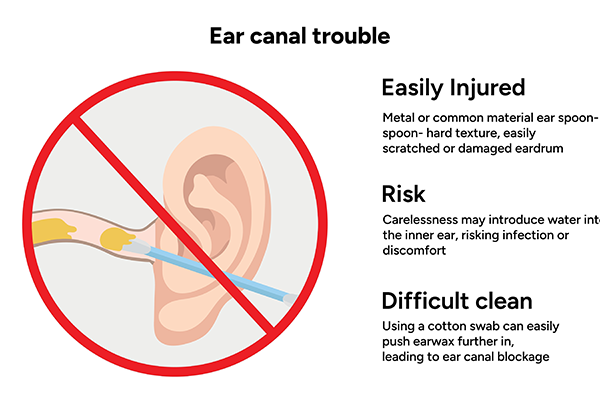
Have you ever had the sensation that you are hearing from inside a tunnel, that sounds are muffled, or that your ear is blocked? Earwax (cerumen) blockage is probably the cause. It's a surprisingly widespread problem that's frequently completely resolvable. This blog will discuss the causes of earwax accumulation, how to determine whether it's a problem, and quick, safe methods to remove it at home and with expert assistance.
Synopsis
First, What Is Earwax and Why Do We Even Have It?
Earwax is actually your ear's bodyguard; despite how disgusting it may seem, it is composed of dust, dead skin cells, ear gland secretions, and other debris. Its duties include:
-
Capturing debris and preventing infections in the ear canal.
-
Serve as a natural lubricant.
-
As it gradually moves outward, it assists in pushing out dangerous particles.
Earwax normally falls out on its own when you move your jaw or chew. However, it occasionally overstays its welcome.

Why Does Earwax Get Blocked?
Earwax blockage occurs when wax builds up faster than the ear can expel it, or when it’s pushed deep into the ear canal. Common causes include:
Using Cotton Swabs (Q-tips)
Ironically, our own attempts to clean our ears are the most frequent offender. Q-tips have a tendency to compact wax close to the eardrum by pushing it deeper.
Earbud Use or Hearing Aids
Regular use of hearing aids, in-ear headphones, or earbuds prevents natural wax migration and promotes accumulation.
Naturally Narrow or Curved Ear Canals
The anatomy of some people's ears simply makes it more difficult for wax to come out.
Overproduction of Earwax
Some people produce more wax than others due to genetics, skin disorders (such as eczema), or persistent irritation.
Ageing
Wax gets drier and harder as we age, which reduces its likelihood of migrating out on its own.
Signs and Symptoms of Earwax Blockage
A wax blockage may be the cause of:
-
Hearing loss
-
Fullness or pressure in the ears
-
Ear pain that is mild
-
Tinnitus, or ear ringing
-
Discharge or itching
-
Sometimes even coughing or lightheadedness (due to nerve stimulation)
If you have severe pain, high fever, or sudden hearing loss, seek medical help immediately; it could be an infection or another underlying issue.
How to Fix Earwax Blockage—Fast and Safely
1. Ear Drops (Wax Softeners)
Over-the-counter cerumenolytic drops are often the first line of defence. They soften hardened wax, making it easier to exit the canal.
Look for:
-
Hydrogen peroxide or carbamide peroxide
-
Olive oil, mineral oil, or glycerin-based solutions
Use for 3–5 days as directed by the physician. Lie on your side while instilling the drops and stay put for a few minutes to let them work.
2. Warm Water Irrigation (After Wax Softens)
You can use a bulb syringe or a special ear irrigation kit to flush out wax with lukewarm water.
-
Tilt your head over a sink
-
Gently squirt warm water into the ear canal
-
Let it drain out and repeat if needed
Do not use irrigation if you have a perforated eardrum, ear tubes, or an active ear infection.
3. Avoid Cotton Swabs and Ear Candles
-
Q-tips push wax deeper—they’re for the outer ear only.
-
Ear candling (burning a hollow candle in the ear) is dangerous and ineffective. It can cause burns or wax drips into the ear canal.
4. See an ENT in Patiala Immediately
If the wax is too stubborn or deeply impacted, visit a professional. They can use:
-
Microsuction (gentle vacuum suction)
-
Curettage (using a loop tool under magnification)
-
Clinical irrigation systems
A trained professional can remove the wax quickly, safely, and painlessly.
How to Prevent Future Earwax Blockages
-
Don't put anything in your ears, not even cotton buds!
-
If you're prone to buildup, use drops once a month.
-
Limit your use of in-ear headphones or clean them frequently. If you wear hearing aids, schedule regular ear exams.
Although it can be bothersome when it accumulates, earwax is necessary for healthy ears. Blockages can be swiftly and safely removed with the correct information and equipment. Therefore, avoid the dangerous do-it-yourself methods and give your ears the attention they need.
Conclusion
Don't hesitate to speak with our ENT specialist in Patiala if you have any questions or if your symptoms don't get better after a few days. Clear, clean (but not too clean) ears are the foundation of healthy hearing!
FAQ's
Earwax blockage occurs when cerumen (earwax) builds up in the ear canal and doesn’t clear out naturally. Common causes include using cotton swabs, earbud use, overproduction of wax, or having narrow/curved ear canals.
No. Cotton swabs often push wax deeper, worsening the blockage. They can also damage the eardrum or ear canal. Earwax should only be cleaned from the outer ear.
Yes. A severe buildup of wax can temporarily muffle or reduce hearing, especially if it completely blocks the ear canal.
You can use:
-
Over-the-counter ear drops (e.g., olive oil- or hydrogen peroxide-based)
-
Warm water irrigation (if the eardrum is intact)
-
Avoid using sharp objects or candles or inserting anything deep into the ear.
See an expert ENT specialist in Patiala if:
-
Home remedies don’t work after a few days
-
You have pain, bleeding, fever, or drainage
-
You suspect a perforated eardrum
-
You use hearing aids or have frequent blockages
No. Earwax is natural and protective. It traps dust, repels water, and prevents infections. It becomes a problem when it's excessive or impacted.





















 5 Min Read
5 Min Read







.png)











